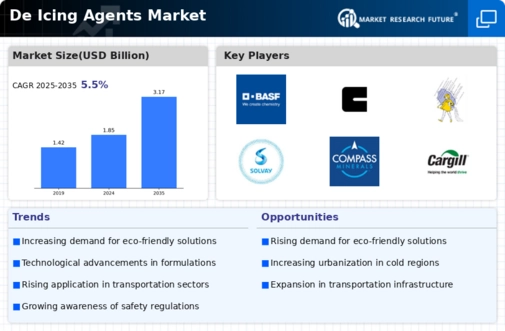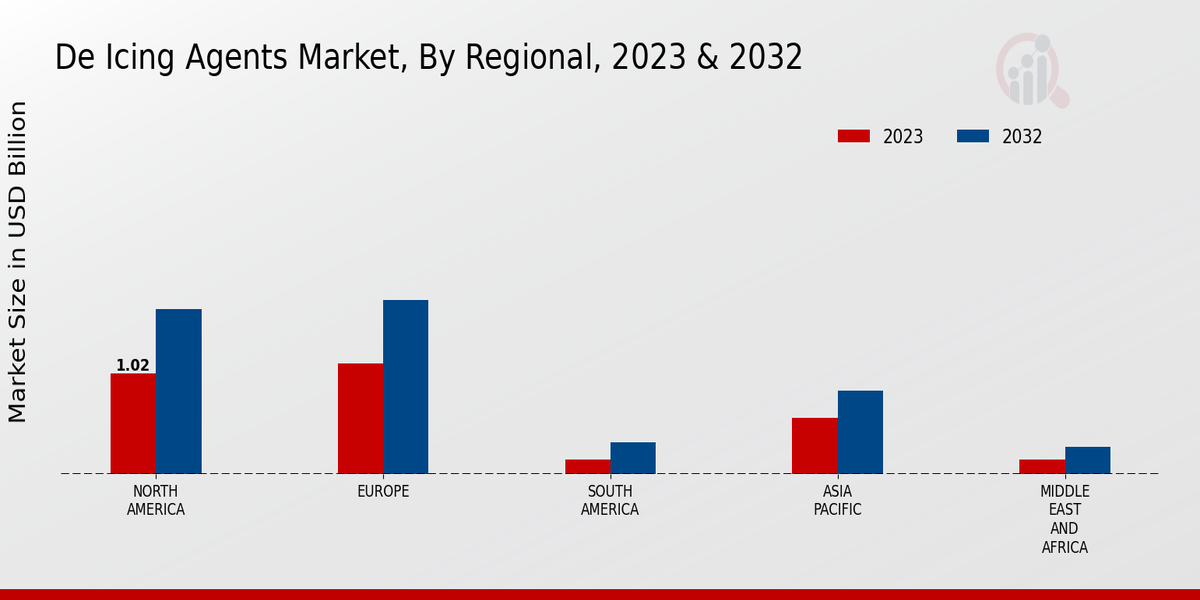Growth in the Aviation Sector
The Global De Icing Agents Market Industry is significantly impacted by the growth in the aviation sector. As air travel continues to rise globally, airports are increasingly investing in de-icing solutions to ensure the safety and efficiency of flight operations during winter months. The need for timely de-icing of aircraft is critical to prevent delays and cancellations, which can have substantial economic implications. This trend is expected to contribute to the market's expansion, with the aviation sector being a key consumer of de-icing agents. The ongoing development of airports and the increase in air traffic are likely to further drive demand in this segment.
Market Trends and Projections
The Global De Icing Agents Market Industry is characterized by various trends and projections that indicate a robust growth trajectory. The market is anticipated to reach 1.85 USD Billion by 2024, with a further increase to 3.17 USD Billion by 2035. This growth reflects a compound annual growth rate (CAGR) of 5.02% from 2025 to 2035, suggesting a strong demand for de-icing solutions across multiple sectors. Factors such as climate change, urbanization, and increased winter weather severity are likely to contribute to this upward trend. The market's dynamics will continue to evolve as stakeholders adapt to changing conditions and consumer preferences.
Increasing Demand for Road Safety
The Global De Icing Agents Market Industry experiences heightened demand due to the increasing emphasis on road safety. As winter weather conditions can lead to hazardous driving situations, municipalities and transportation agencies are investing in de-icing solutions to ensure safer roadways. For instance, the use of de-icing agents has been shown to reduce accident rates significantly during winter months. The market is projected to reach 1.85 USD Billion in 2024, reflecting a growing recognition of the importance of maintaining safe transportation networks. This trend is likely to continue as urbanization increases and more regions face severe winter weather.
Expansion of Infrastructure Projects
The Global De Icing Agents Market Industry is bolstered by the expansion of infrastructure projects worldwide. Governments are increasingly allocating budgets for road maintenance and development, particularly in regions prone to heavy snowfall. This investment translates into a higher demand for de-icing agents to ensure that newly constructed roads remain safe and accessible during winter. As infrastructure projects proliferate, the market is expected to grow, with projections indicating a rise to 3.17 USD Billion by 2035. The integration of de-icing solutions into planning and execution phases of infrastructure projects is becoming a standard practice, further driving market growth.
Technological Advancements in De-Icing Solutions
The Global De Icing Agents Market Industry is experiencing a transformation due to technological advancements in de-icing solutions. Innovations such as the development of smart de-icing agents that respond to temperature changes and the introduction of automated application systems are enhancing the effectiveness and efficiency of de-icing operations. These advancements not only improve the performance of de-icing agents but also reduce waste and environmental impact. As technology continues to evolve, the market is poised for growth, with a projected CAGR of 5.02% from 2025 to 2035, indicating a strong future for advanced de-icing solutions.
Environmental Regulations and Sustainable Practices
The Global De Icing Agents Market Industry is influenced by stringent environmental regulations that encourage the use of eco-friendly de-icing agents. As governments worldwide implement policies aimed at reducing the environmental impact of traditional de-icing materials, there is a shift towards more sustainable alternatives. This transition is evident in the increasing adoption of organic and biodegradable de-icing agents, which are perceived as less harmful to ecosystems. The market's growth is likely to be supported by these regulatory frameworks, as they not only promote sustainability but also enhance public awareness regarding environmental issues associated with conventional de-icing agents.








